Marketing Essentials: A Comparative Analysis of Unilever and P&G
VerifiedAdded on 2023/01/05
|15
|4373
|51
Report
AI Summary
This report provides a comprehensive overview of marketing essentials, focusing on the strategies of Unilever. It begins with an introduction to the significance of marketing in shaping organizational success and market awareness. The report delves into the roles and responsibilities of the marketing function, exploring its interconnection with other organizational units such as HR, Finance, Operations, and R&D. A significant portion of the report is dedicated to a comparative analysis of the marketing mix of Unilever and Procter & Gamble, examining their product strategies, pricing policies, distribution networks, and promotional activities. Furthermore, the report outlines a basic marketing plan for Unilever, offering recommendations for improvements. Overall, the report aims to provide insights into effective marketing practices and strategies within the fast-moving consumer goods industry.
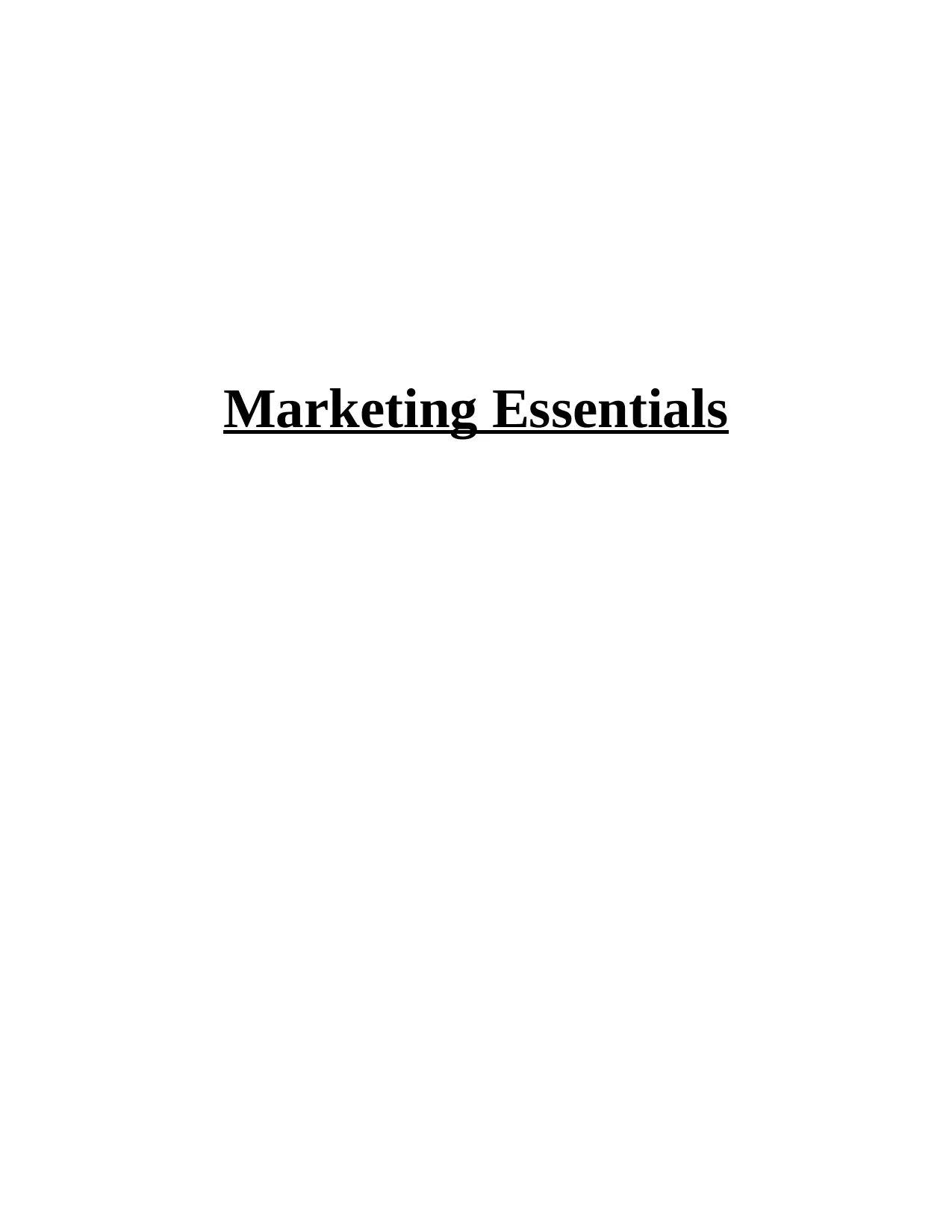
Marketing Essentials
Paraphrase This Document
Need a fresh take? Get an instant paraphrase of this document with our AI Paraphraser
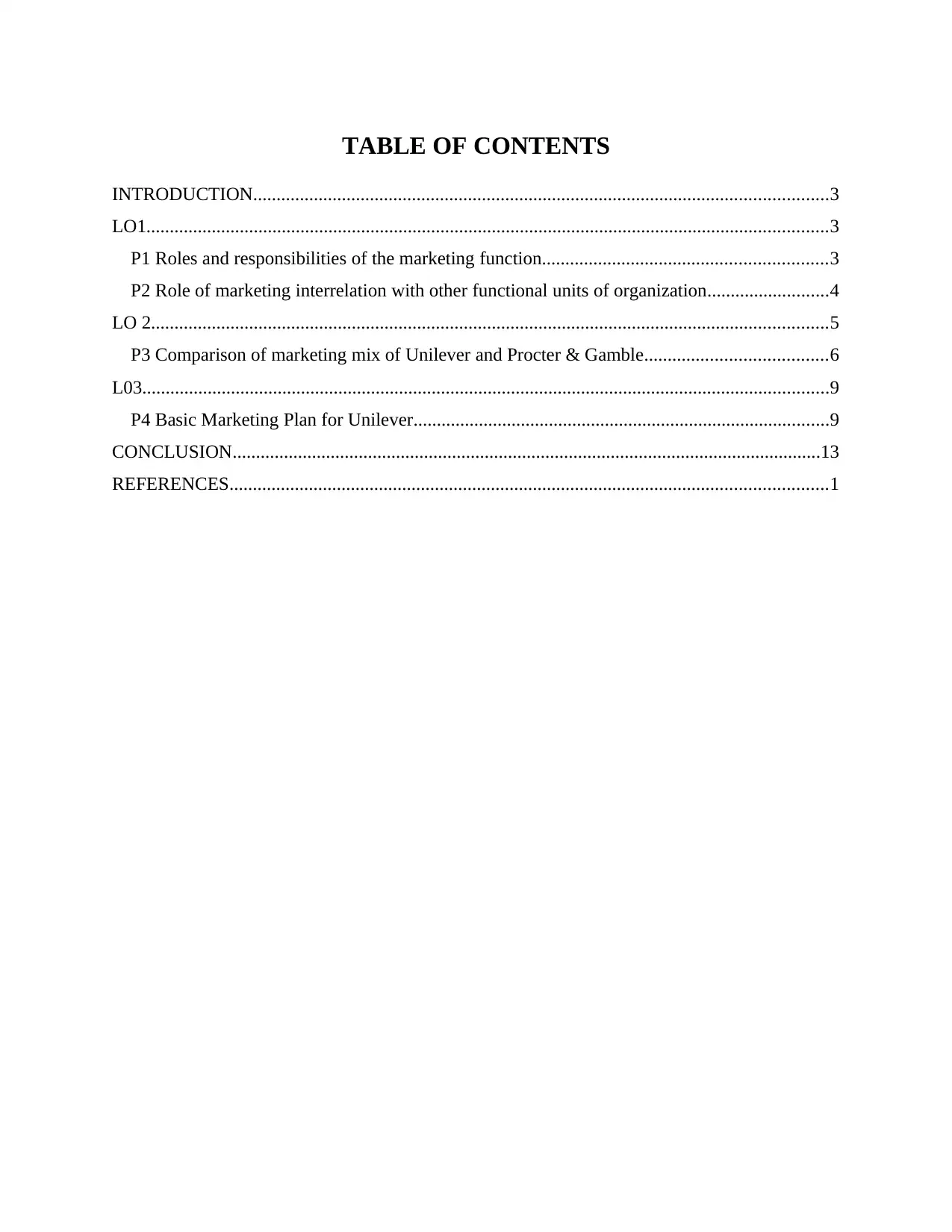
TABLE OF CONTENTS
INTRODUCTION...........................................................................................................................3
LO1..................................................................................................................................................3
P1 Roles and responsibilities of the marketing function.............................................................3
P2 Role of marketing interrelation with other functional units of organization..........................4
LO 2.................................................................................................................................................5
P3 Comparison of marketing mix of Unilever and Procter & Gamble.......................................6
L03...................................................................................................................................................9
P4 Basic Marketing Plan for Unilever.........................................................................................9
CONCLUSION..............................................................................................................................13
REFERENCES................................................................................................................................1
INTRODUCTION...........................................................................................................................3
LO1..................................................................................................................................................3
P1 Roles and responsibilities of the marketing function.............................................................3
P2 Role of marketing interrelation with other functional units of organization..........................4
LO 2.................................................................................................................................................5
P3 Comparison of marketing mix of Unilever and Procter & Gamble.......................................6
L03...................................................................................................................................................9
P4 Basic Marketing Plan for Unilever.........................................................................................9
CONCLUSION..............................................................................................................................13
REFERENCES................................................................................................................................1
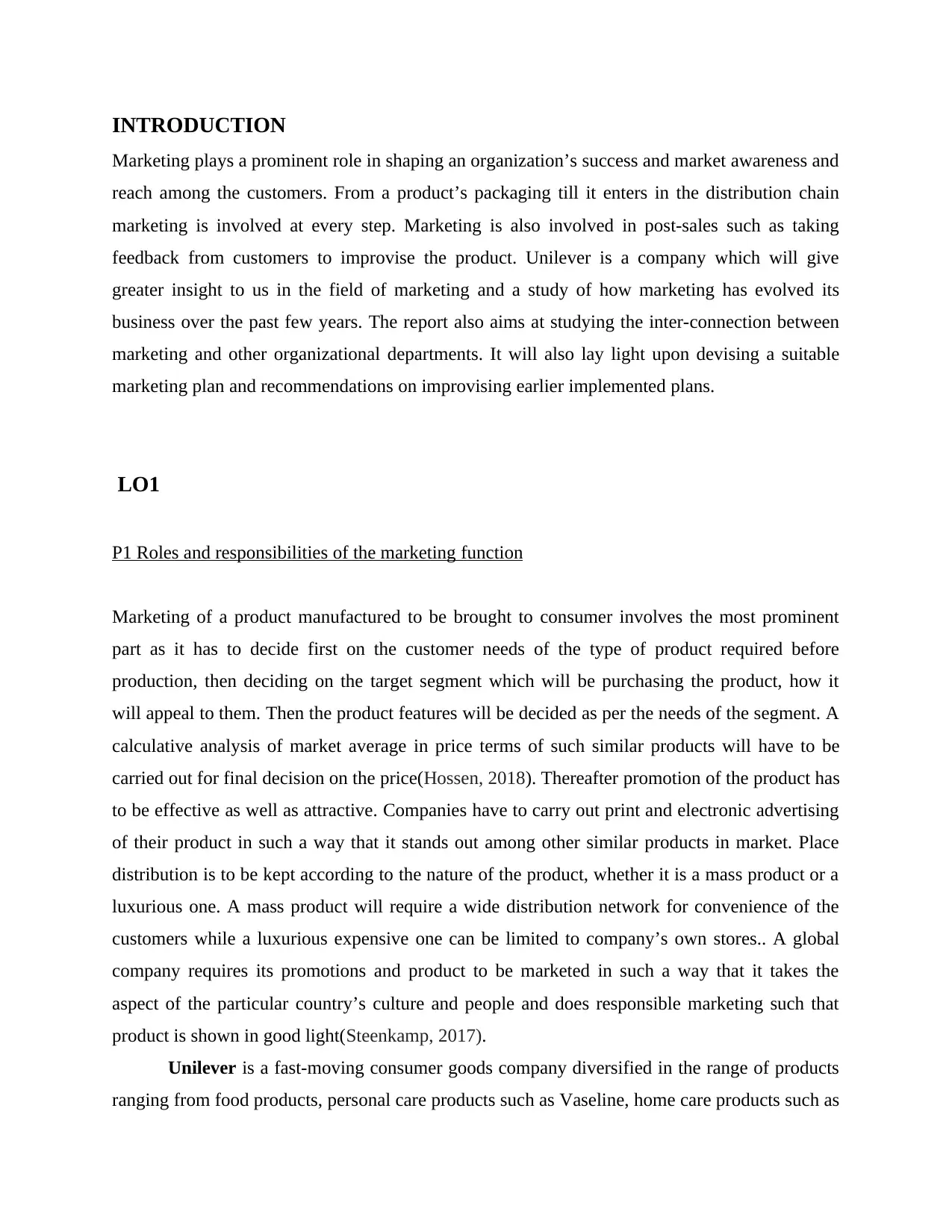
INTRODUCTION
Marketing plays a prominent role in shaping an organization’s success and market awareness and
reach among the customers. From a product’s packaging till it enters in the distribution chain
marketing is involved at every step. Marketing is also involved in post-sales such as taking
feedback from customers to improvise the product. Unilever is a company which will give
greater insight to us in the field of marketing and a study of how marketing has evolved its
business over the past few years. The report also aims at studying the inter-connection between
marketing and other organizational departments. It will also lay light upon devising a suitable
marketing plan and recommendations on improvising earlier implemented plans.
LO1
P1 Roles and responsibilities of the marketing function
Marketing of a product manufactured to be brought to consumer involves the most prominent
part as it has to decide first on the customer needs of the type of product required before
production, then deciding on the target segment which will be purchasing the product, how it
will appeal to them. Then the product features will be decided as per the needs of the segment. A
calculative analysis of market average in price terms of such similar products will have to be
carried out for final decision on the price(Hossen, 2018). Thereafter promotion of the product has
to be effective as well as attractive. Companies have to carry out print and electronic advertising
of their product in such a way that it stands out among other similar products in market. Place
distribution is to be kept according to the nature of the product, whether it is a mass product or a
luxurious one. A mass product will require a wide distribution network for convenience of the
customers while a luxurious expensive one can be limited to company’s own stores.. A global
company requires its promotions and product to be marketed in such a way that it takes the
aspect of the particular country’s culture and people and does responsible marketing such that
product is shown in good light(Steenkamp, 2017).
Unilever is a fast-moving consumer goods company diversified in the range of products
ranging from food products, personal care products such as Vaseline, home care products such as
Marketing plays a prominent role in shaping an organization’s success and market awareness and
reach among the customers. From a product’s packaging till it enters in the distribution chain
marketing is involved at every step. Marketing is also involved in post-sales such as taking
feedback from customers to improvise the product. Unilever is a company which will give
greater insight to us in the field of marketing and a study of how marketing has evolved its
business over the past few years. The report also aims at studying the inter-connection between
marketing and other organizational departments. It will also lay light upon devising a suitable
marketing plan and recommendations on improvising earlier implemented plans.
LO1
P1 Roles and responsibilities of the marketing function
Marketing of a product manufactured to be brought to consumer involves the most prominent
part as it has to decide first on the customer needs of the type of product required before
production, then deciding on the target segment which will be purchasing the product, how it
will appeal to them. Then the product features will be decided as per the needs of the segment. A
calculative analysis of market average in price terms of such similar products will have to be
carried out for final decision on the price(Hossen, 2018). Thereafter promotion of the product has
to be effective as well as attractive. Companies have to carry out print and electronic advertising
of their product in such a way that it stands out among other similar products in market. Place
distribution is to be kept according to the nature of the product, whether it is a mass product or a
luxurious one. A mass product will require a wide distribution network for convenience of the
customers while a luxurious expensive one can be limited to company’s own stores.. A global
company requires its promotions and product to be marketed in such a way that it takes the
aspect of the particular country’s culture and people and does responsible marketing such that
product is shown in good light(Steenkamp, 2017).
Unilever is a fast-moving consumer goods company diversified in the range of products
ranging from food products, personal care products such as Vaseline, home care products such as
⊘ This is a preview!⊘
Do you want full access?
Subscribe today to unlock all pages.

Trusted by 1+ million students worldwide
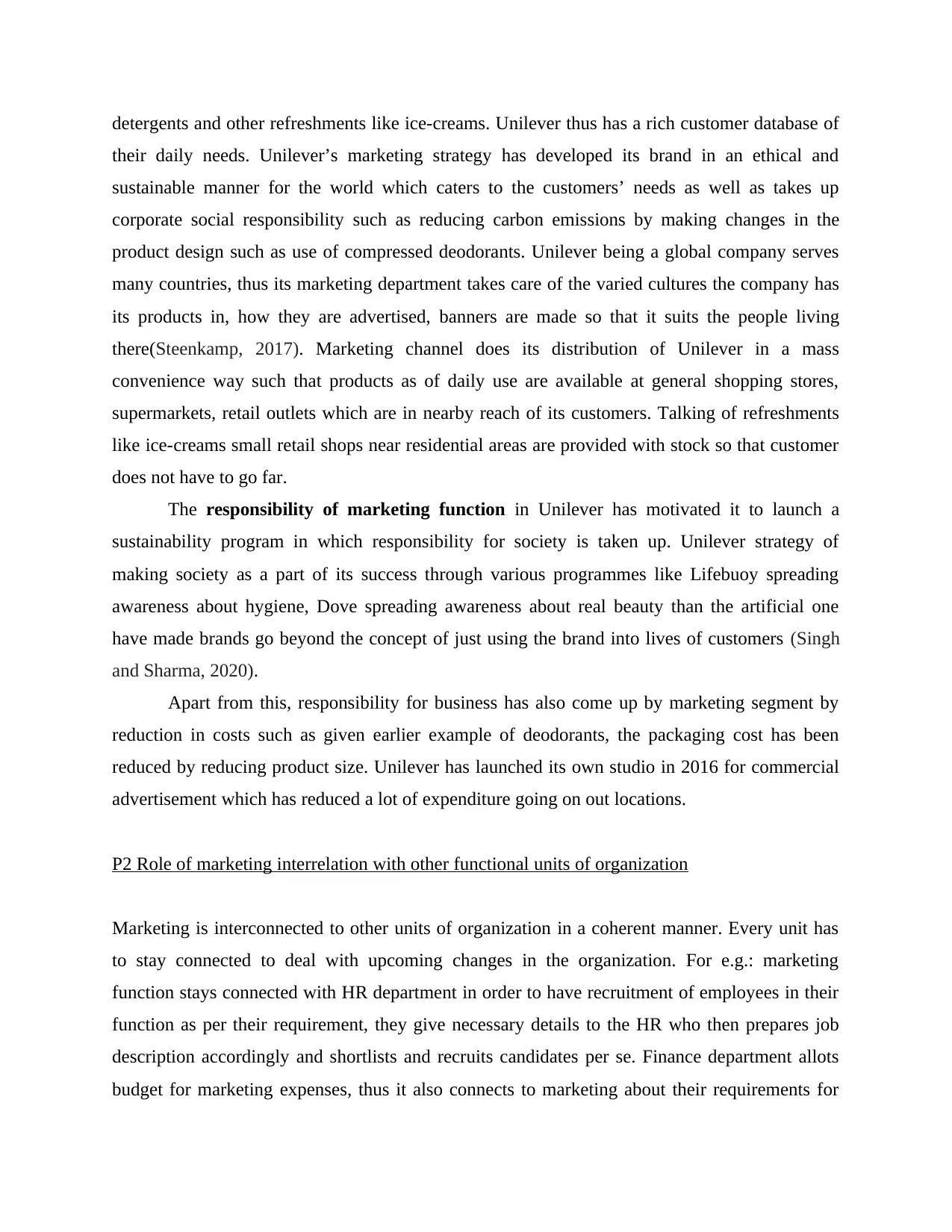
detergents and other refreshments like ice-creams. Unilever thus has a rich customer database of
their daily needs. Unilever’s marketing strategy has developed its brand in an ethical and
sustainable manner for the world which caters to the customers’ needs as well as takes up
corporate social responsibility such as reducing carbon emissions by making changes in the
product design such as use of compressed deodorants. Unilever being a global company serves
many countries, thus its marketing department takes care of the varied cultures the company has
its products in, how they are advertised, banners are made so that it suits the people living
there(Steenkamp, 2017). Marketing channel does its distribution of Unilever in a mass
convenience way such that products as of daily use are available at general shopping stores,
supermarkets, retail outlets which are in nearby reach of its customers. Talking of refreshments
like ice-creams small retail shops near residential areas are provided with stock so that customer
does not have to go far.
The responsibility of marketing function in Unilever has motivated it to launch a
sustainability program in which responsibility for society is taken up. Unilever strategy of
making society as a part of its success through various programmes like Lifebuoy spreading
awareness about hygiene, Dove spreading awareness about real beauty than the artificial one
have made brands go beyond the concept of just using the brand into lives of customers (Singh
and Sharma, 2020).
Apart from this, responsibility for business has also come up by marketing segment by
reduction in costs such as given earlier example of deodorants, the packaging cost has been
reduced by reducing product size. Unilever has launched its own studio in 2016 for commercial
advertisement which has reduced a lot of expenditure going on out locations.
P2 Role of marketing interrelation with other functional units of organization
Marketing is interconnected to other units of organization in a coherent manner. Every unit has
to stay connected to deal with upcoming changes in the organization. For e.g.: marketing
function stays connected with HR department in order to have recruitment of employees in their
function as per their requirement, they give necessary details to the HR who then prepares job
description accordingly and shortlists and recruits candidates per se. Finance department allots
budget for marketing expenses, thus it also connects to marketing about their requirements for
their daily needs. Unilever’s marketing strategy has developed its brand in an ethical and
sustainable manner for the world which caters to the customers’ needs as well as takes up
corporate social responsibility such as reducing carbon emissions by making changes in the
product design such as use of compressed deodorants. Unilever being a global company serves
many countries, thus its marketing department takes care of the varied cultures the company has
its products in, how they are advertised, banners are made so that it suits the people living
there(Steenkamp, 2017). Marketing channel does its distribution of Unilever in a mass
convenience way such that products as of daily use are available at general shopping stores,
supermarkets, retail outlets which are in nearby reach of its customers. Talking of refreshments
like ice-creams small retail shops near residential areas are provided with stock so that customer
does not have to go far.
The responsibility of marketing function in Unilever has motivated it to launch a
sustainability program in which responsibility for society is taken up. Unilever strategy of
making society as a part of its success through various programmes like Lifebuoy spreading
awareness about hygiene, Dove spreading awareness about real beauty than the artificial one
have made brands go beyond the concept of just using the brand into lives of customers (Singh
and Sharma, 2020).
Apart from this, responsibility for business has also come up by marketing segment by
reduction in costs such as given earlier example of deodorants, the packaging cost has been
reduced by reducing product size. Unilever has launched its own studio in 2016 for commercial
advertisement which has reduced a lot of expenditure going on out locations.
P2 Role of marketing interrelation with other functional units of organization
Marketing is interconnected to other units of organization in a coherent manner. Every unit has
to stay connected to deal with upcoming changes in the organization. For e.g.: marketing
function stays connected with HR department in order to have recruitment of employees in their
function as per their requirement, they give necessary details to the HR who then prepares job
description accordingly and shortlists and recruits candidates per se. Finance department allots
budget for marketing expenses, thus it also connects to marketing about their requirements for
Paraphrase This Document
Need a fresh take? Get an instant paraphrase of this document with our AI Paraphraser
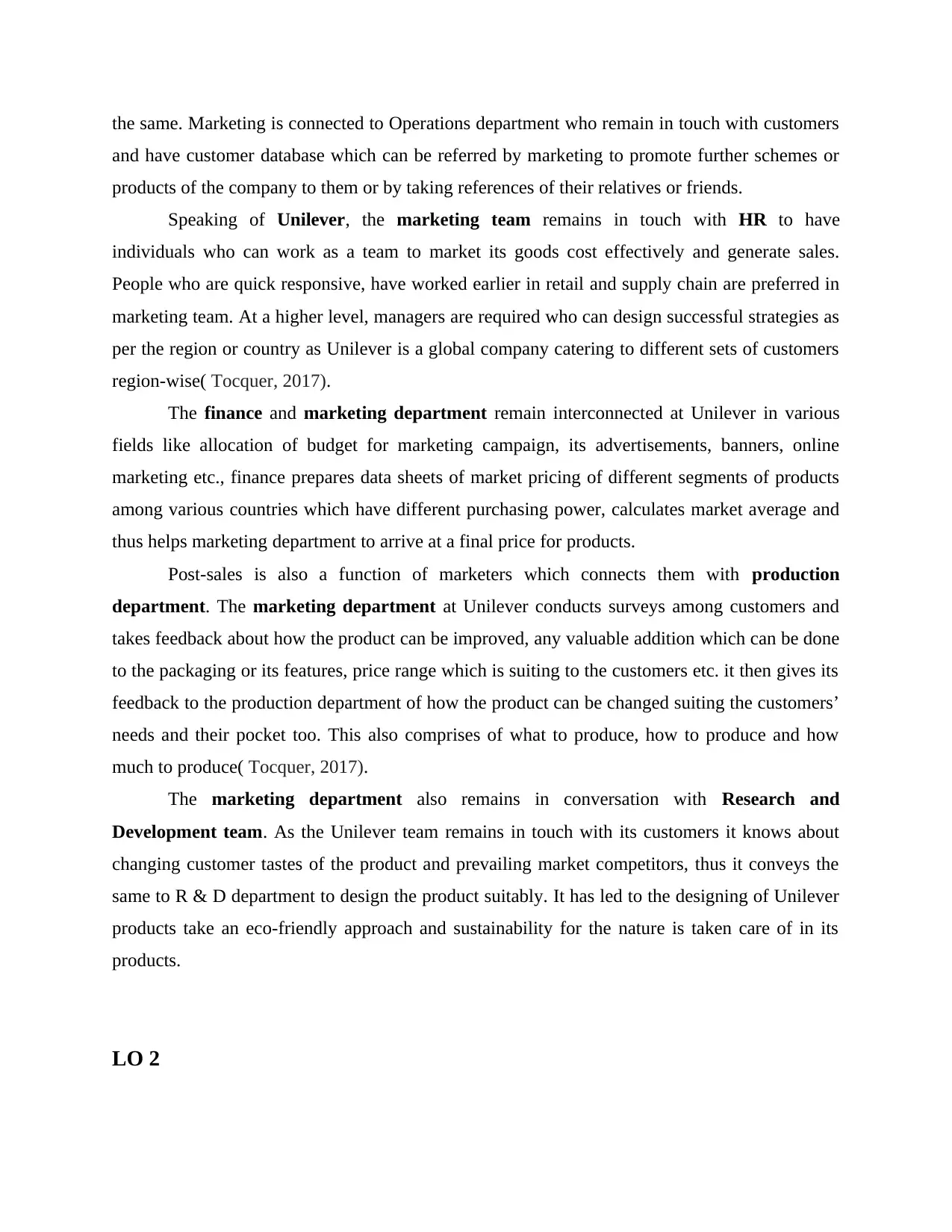
the same. Marketing is connected to Operations department who remain in touch with customers
and have customer database which can be referred by marketing to promote further schemes or
products of the company to them or by taking references of their relatives or friends.
Speaking of Unilever, the marketing team remains in touch with HR to have
individuals who can work as a team to market its goods cost effectively and generate sales.
People who are quick responsive, have worked earlier in retail and supply chain are preferred in
marketing team. At a higher level, managers are required who can design successful strategies as
per the region or country as Unilever is a global company catering to different sets of customers
region-wise( Tocquer, 2017).
The finance and marketing department remain interconnected at Unilever in various
fields like allocation of budget for marketing campaign, its advertisements, banners, online
marketing etc., finance prepares data sheets of market pricing of different segments of products
among various countries which have different purchasing power, calculates market average and
thus helps marketing department to arrive at a final price for products.
Post-sales is also a function of marketers which connects them with production
department. The marketing department at Unilever conducts surveys among customers and
takes feedback about how the product can be improved, any valuable addition which can be done
to the packaging or its features, price range which is suiting to the customers etc. it then gives its
feedback to the production department of how the product can be changed suiting the customers’
needs and their pocket too. This also comprises of what to produce, how to produce and how
much to produce( Tocquer, 2017).
The marketing department also remains in conversation with Research and
Development team. As the Unilever team remains in touch with its customers it knows about
changing customer tastes of the product and prevailing market competitors, thus it conveys the
same to R & D department to design the product suitably. It has led to the designing of Unilever
products take an eco-friendly approach and sustainability for the nature is taken care of in its
products.
LO 2
and have customer database which can be referred by marketing to promote further schemes or
products of the company to them or by taking references of their relatives or friends.
Speaking of Unilever, the marketing team remains in touch with HR to have
individuals who can work as a team to market its goods cost effectively and generate sales.
People who are quick responsive, have worked earlier in retail and supply chain are preferred in
marketing team. At a higher level, managers are required who can design successful strategies as
per the region or country as Unilever is a global company catering to different sets of customers
region-wise( Tocquer, 2017).
The finance and marketing department remain interconnected at Unilever in various
fields like allocation of budget for marketing campaign, its advertisements, banners, online
marketing etc., finance prepares data sheets of market pricing of different segments of products
among various countries which have different purchasing power, calculates market average and
thus helps marketing department to arrive at a final price for products.
Post-sales is also a function of marketers which connects them with production
department. The marketing department at Unilever conducts surveys among customers and
takes feedback about how the product can be improved, any valuable addition which can be done
to the packaging or its features, price range which is suiting to the customers etc. it then gives its
feedback to the production department of how the product can be changed suiting the customers’
needs and their pocket too. This also comprises of what to produce, how to produce and how
much to produce( Tocquer, 2017).
The marketing department also remains in conversation with Research and
Development team. As the Unilever team remains in touch with its customers it knows about
changing customer tastes of the product and prevailing market competitors, thus it conveys the
same to R & D department to design the product suitably. It has led to the designing of Unilever
products take an eco-friendly approach and sustainability for the nature is taken care of in its
products.
LO 2
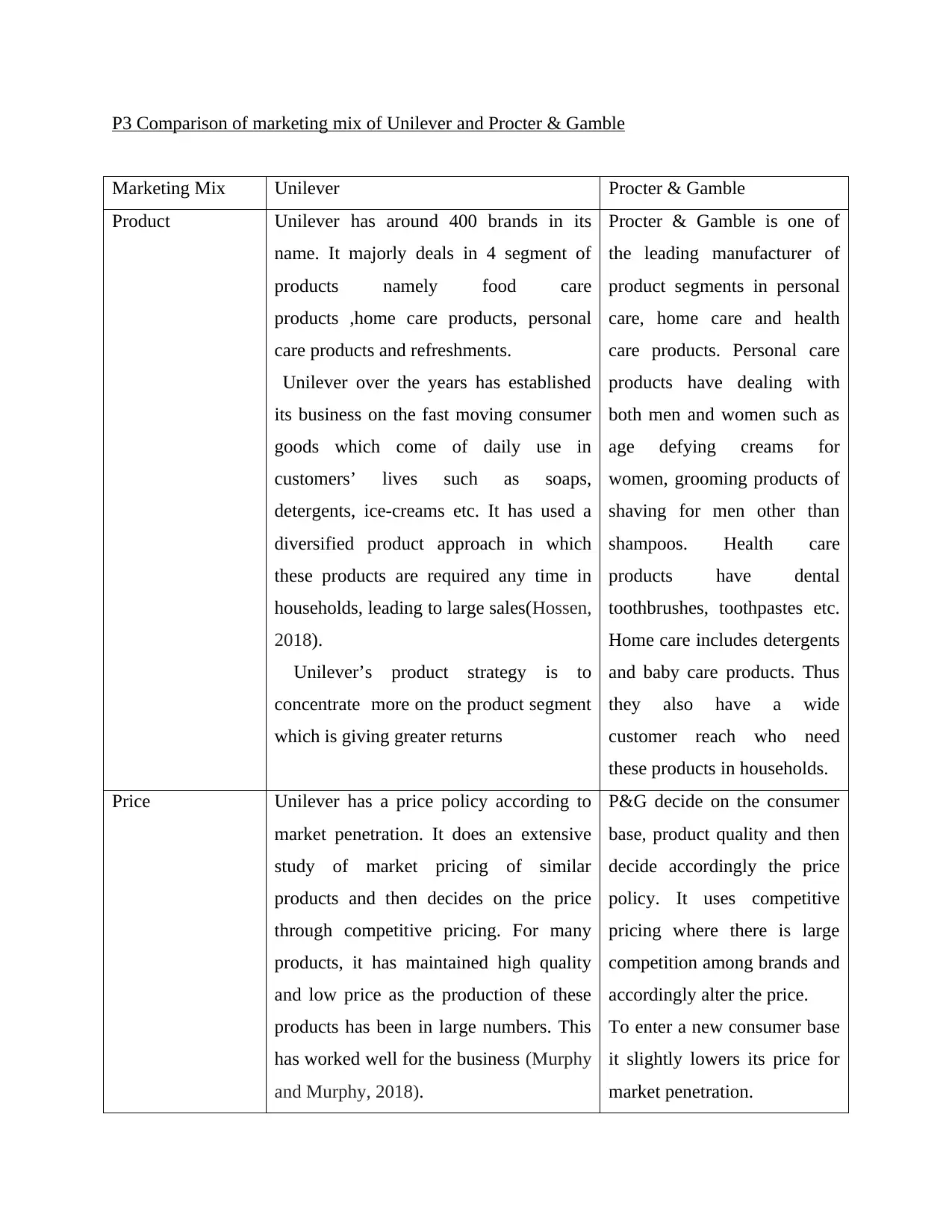
P3 Comparison of marketing mix of Unilever and Procter & Gamble
Marketing Mix Unilever Procter & Gamble
Product Unilever has around 400 brands in its
name. It majorly deals in 4 segment of
products namely food care
products ,home care products, personal
care products and refreshments.
Unilever over the years has established
its business on the fast moving consumer
goods which come of daily use in
customers’ lives such as soaps,
detergents, ice-creams etc. It has used a
diversified product approach in which
these products are required any time in
households, leading to large sales(Hossen,
2018).
Unilever’s product strategy is to
concentrate more on the product segment
which is giving greater returns
Procter & Gamble is one of
the leading manufacturer of
product segments in personal
care, home care and health
care products. Personal care
products have dealing with
both men and women such as
age defying creams for
women, grooming products of
shaving for men other than
shampoos. Health care
products have dental
toothbrushes, toothpastes etc.
Home care includes detergents
and baby care products. Thus
they also have a wide
customer reach who need
these products in households.
Price Unilever has a price policy according to
market penetration. It does an extensive
study of market pricing of similar
products and then decides on the price
through competitive pricing. For many
products, it has maintained high quality
and low price as the production of these
products has been in large numbers. This
has worked well for the business (Murphy
and Murphy, 2018).
P&G decide on the consumer
base, product quality and then
decide accordingly the price
policy. It uses competitive
pricing where there is large
competition among brands and
accordingly alter the price.
To enter a new consumer base
it slightly lowers its price for
market penetration.
Marketing Mix Unilever Procter & Gamble
Product Unilever has around 400 brands in its
name. It majorly deals in 4 segment of
products namely food care
products ,home care products, personal
care products and refreshments.
Unilever over the years has established
its business on the fast moving consumer
goods which come of daily use in
customers’ lives such as soaps,
detergents, ice-creams etc. It has used a
diversified product approach in which
these products are required any time in
households, leading to large sales(Hossen,
2018).
Unilever’s product strategy is to
concentrate more on the product segment
which is giving greater returns
Procter & Gamble is one of
the leading manufacturer of
product segments in personal
care, home care and health
care products. Personal care
products have dealing with
both men and women such as
age defying creams for
women, grooming products of
shaving for men other than
shampoos. Health care
products have dental
toothbrushes, toothpastes etc.
Home care includes detergents
and baby care products. Thus
they also have a wide
customer reach who need
these products in households.
Price Unilever has a price policy according to
market penetration. It does an extensive
study of market pricing of similar
products and then decides on the price
through competitive pricing. For many
products, it has maintained high quality
and low price as the production of these
products has been in large numbers. This
has worked well for the business (Murphy
and Murphy, 2018).
P&G decide on the consumer
base, product quality and then
decide accordingly the price
policy. It uses competitive
pricing where there is large
competition among brands and
accordingly alter the price.
To enter a new consumer base
it slightly lowers its price for
market penetration.
⊘ This is a preview!⊘
Do you want full access?
Subscribe today to unlock all pages.

Trusted by 1+ million students worldwide
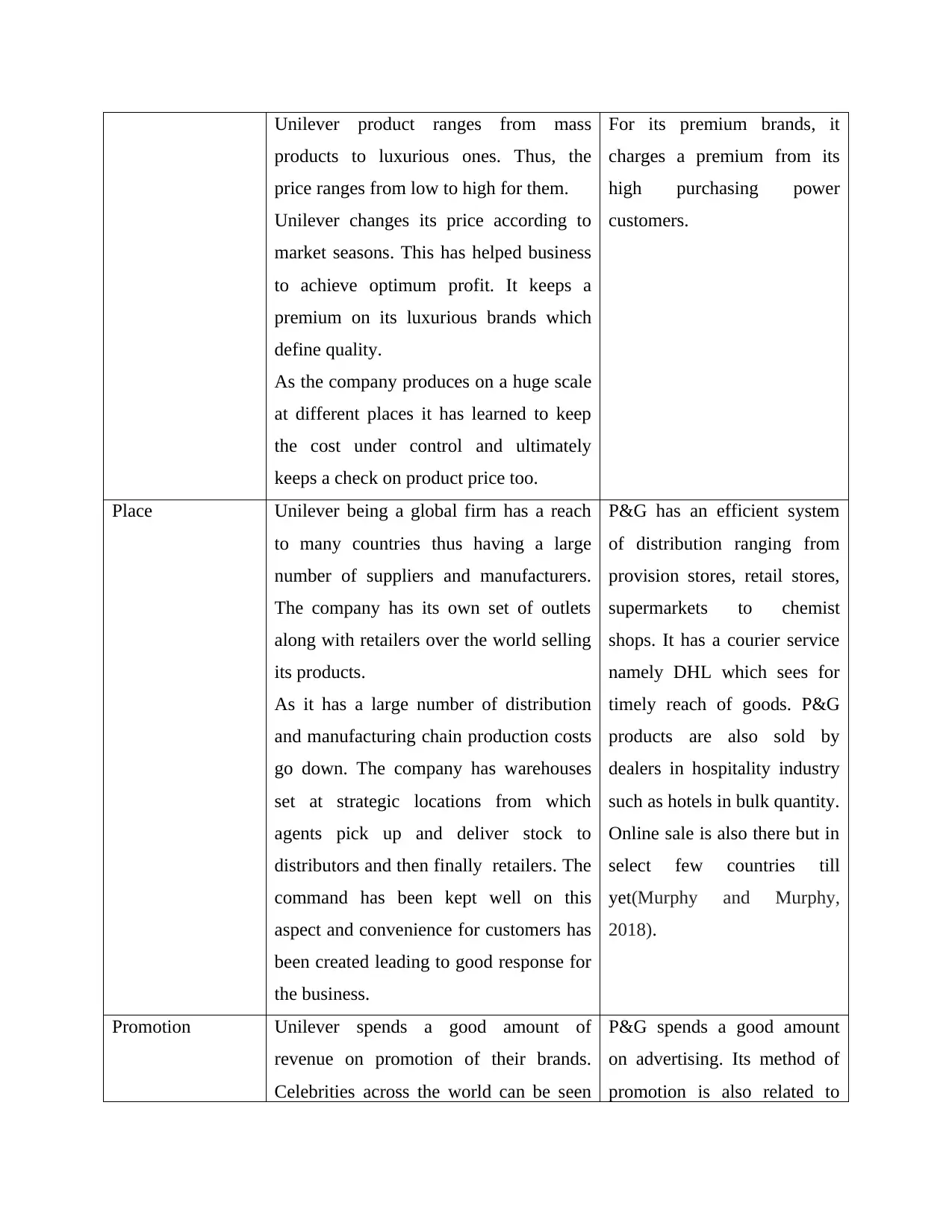
Unilever product ranges from mass
products to luxurious ones. Thus, the
price ranges from low to high for them.
Unilever changes its price according to
market seasons. This has helped business
to achieve optimum profit. It keeps a
premium on its luxurious brands which
define quality.
As the company produces on a huge scale
at different places it has learned to keep
the cost under control and ultimately
keeps a check on product price too.
For its premium brands, it
charges a premium from its
high purchasing power
customers.
Place Unilever being a global firm has a reach
to many countries thus having a large
number of suppliers and manufacturers.
The company has its own set of outlets
along with retailers over the world selling
its products.
As it has a large number of distribution
and manufacturing chain production costs
go down. The company has warehouses
set at strategic locations from which
agents pick up and deliver stock to
distributors and then finally retailers. The
command has been kept well on this
aspect and convenience for customers has
been created leading to good response for
the business.
P&G has an efficient system
of distribution ranging from
provision stores, retail stores,
supermarkets to chemist
shops. It has a courier service
namely DHL which sees for
timely reach of goods. P&G
products are also sold by
dealers in hospitality industry
such as hotels in bulk quantity.
Online sale is also there but in
select few countries till
yet(Murphy and Murphy,
2018).
Promotion Unilever spends a good amount of
revenue on promotion of their brands.
Celebrities across the world can be seen
P&G spends a good amount
on advertising. Its method of
promotion is also related to
products to luxurious ones. Thus, the
price ranges from low to high for them.
Unilever changes its price according to
market seasons. This has helped business
to achieve optimum profit. It keeps a
premium on its luxurious brands which
define quality.
As the company produces on a huge scale
at different places it has learned to keep
the cost under control and ultimately
keeps a check on product price too.
For its premium brands, it
charges a premium from its
high purchasing power
customers.
Place Unilever being a global firm has a reach
to many countries thus having a large
number of suppliers and manufacturers.
The company has its own set of outlets
along with retailers over the world selling
its products.
As it has a large number of distribution
and manufacturing chain production costs
go down. The company has warehouses
set at strategic locations from which
agents pick up and deliver stock to
distributors and then finally retailers. The
command has been kept well on this
aspect and convenience for customers has
been created leading to good response for
the business.
P&G has an efficient system
of distribution ranging from
provision stores, retail stores,
supermarkets to chemist
shops. It has a courier service
namely DHL which sees for
timely reach of goods. P&G
products are also sold by
dealers in hospitality industry
such as hotels in bulk quantity.
Online sale is also there but in
select few countries till
yet(Murphy and Murphy,
2018).
Promotion Unilever spends a good amount of
revenue on promotion of their brands.
Celebrities across the world can be seen
P&G spends a good amount
on advertising. Its method of
promotion is also related to
Paraphrase This Document
Need a fresh take? Get an instant paraphrase of this document with our AI Paraphraser
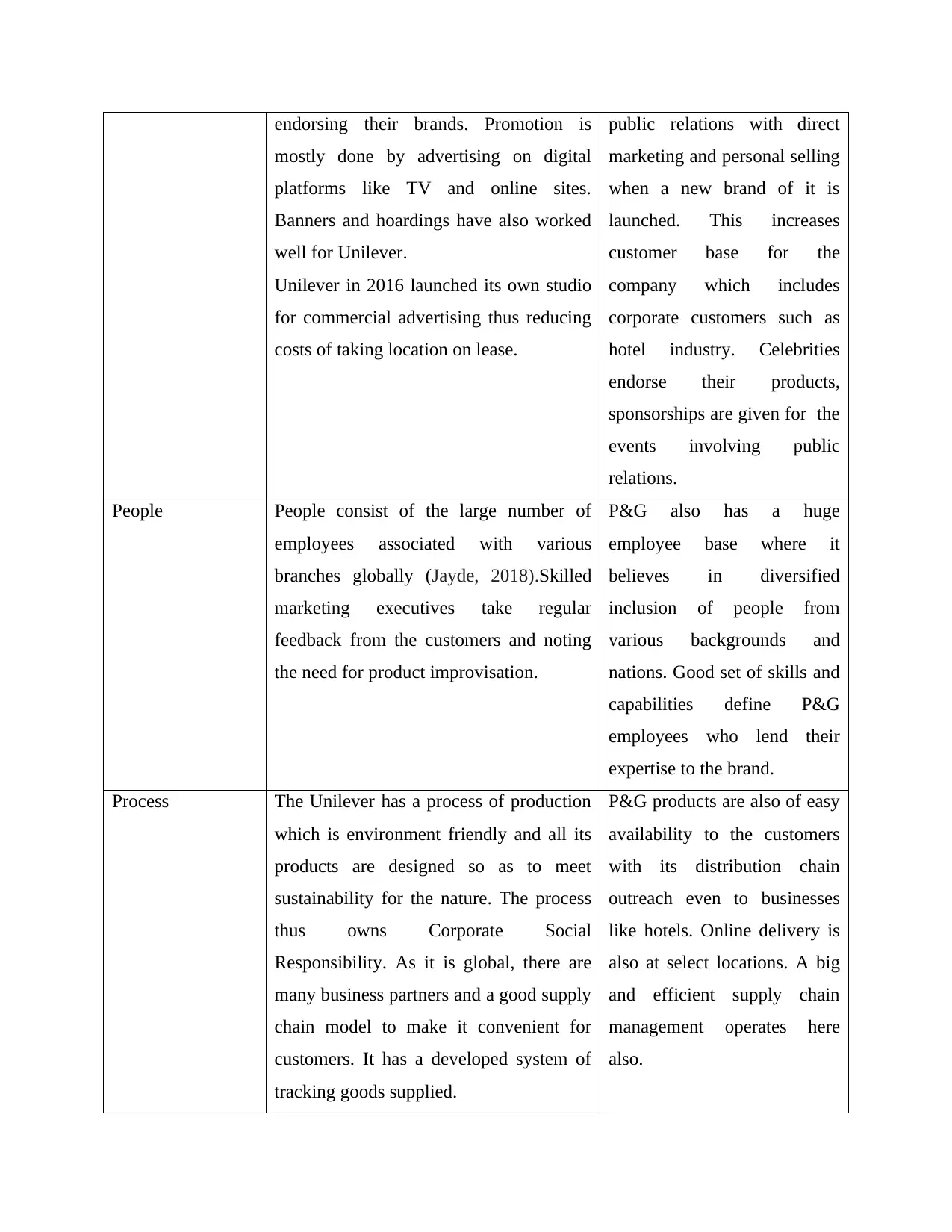
endorsing their brands. Promotion is
mostly done by advertising on digital
platforms like TV and online sites.
Banners and hoardings have also worked
well for Unilever.
Unilever in 2016 launched its own studio
for commercial advertising thus reducing
costs of taking location on lease.
public relations with direct
marketing and personal selling
when a new brand of it is
launched. This increases
customer base for the
company which includes
corporate customers such as
hotel industry. Celebrities
endorse their products,
sponsorships are given for the
events involving public
relations.
People People consist of the large number of
employees associated with various
branches globally (Jayde, 2018).Skilled
marketing executives take regular
feedback from the customers and noting
the need for product improvisation.
P&G also has a huge
employee base where it
believes in diversified
inclusion of people from
various backgrounds and
nations. Good set of skills and
capabilities define P&G
employees who lend their
expertise to the brand.
Process The Unilever has a process of production
which is environment friendly and all its
products are designed so as to meet
sustainability for the nature. The process
thus owns Corporate Social
Responsibility. As it is global, there are
many business partners and a good supply
chain model to make it convenient for
customers. It has a developed system of
tracking goods supplied.
P&G products are also of easy
availability to the customers
with its distribution chain
outreach even to businesses
like hotels. Online delivery is
also at select locations. A big
and efficient supply chain
management operates here
also.
mostly done by advertising on digital
platforms like TV and online sites.
Banners and hoardings have also worked
well for Unilever.
Unilever in 2016 launched its own studio
for commercial advertising thus reducing
costs of taking location on lease.
public relations with direct
marketing and personal selling
when a new brand of it is
launched. This increases
customer base for the
company which includes
corporate customers such as
hotel industry. Celebrities
endorse their products,
sponsorships are given for the
events involving public
relations.
People People consist of the large number of
employees associated with various
branches globally (Jayde, 2018).Skilled
marketing executives take regular
feedback from the customers and noting
the need for product improvisation.
P&G also has a huge
employee base where it
believes in diversified
inclusion of people from
various backgrounds and
nations. Good set of skills and
capabilities define P&G
employees who lend their
expertise to the brand.
Process The Unilever has a process of production
which is environment friendly and all its
products are designed so as to meet
sustainability for the nature. The process
thus owns Corporate Social
Responsibility. As it is global, there are
many business partners and a good supply
chain model to make it convenient for
customers. It has a developed system of
tracking goods supplied.
P&G products are also of easy
availability to the customers
with its distribution chain
outreach even to businesses
like hotels. Online delivery is
also at select locations. A big
and efficient supply chain
management operates here
also.
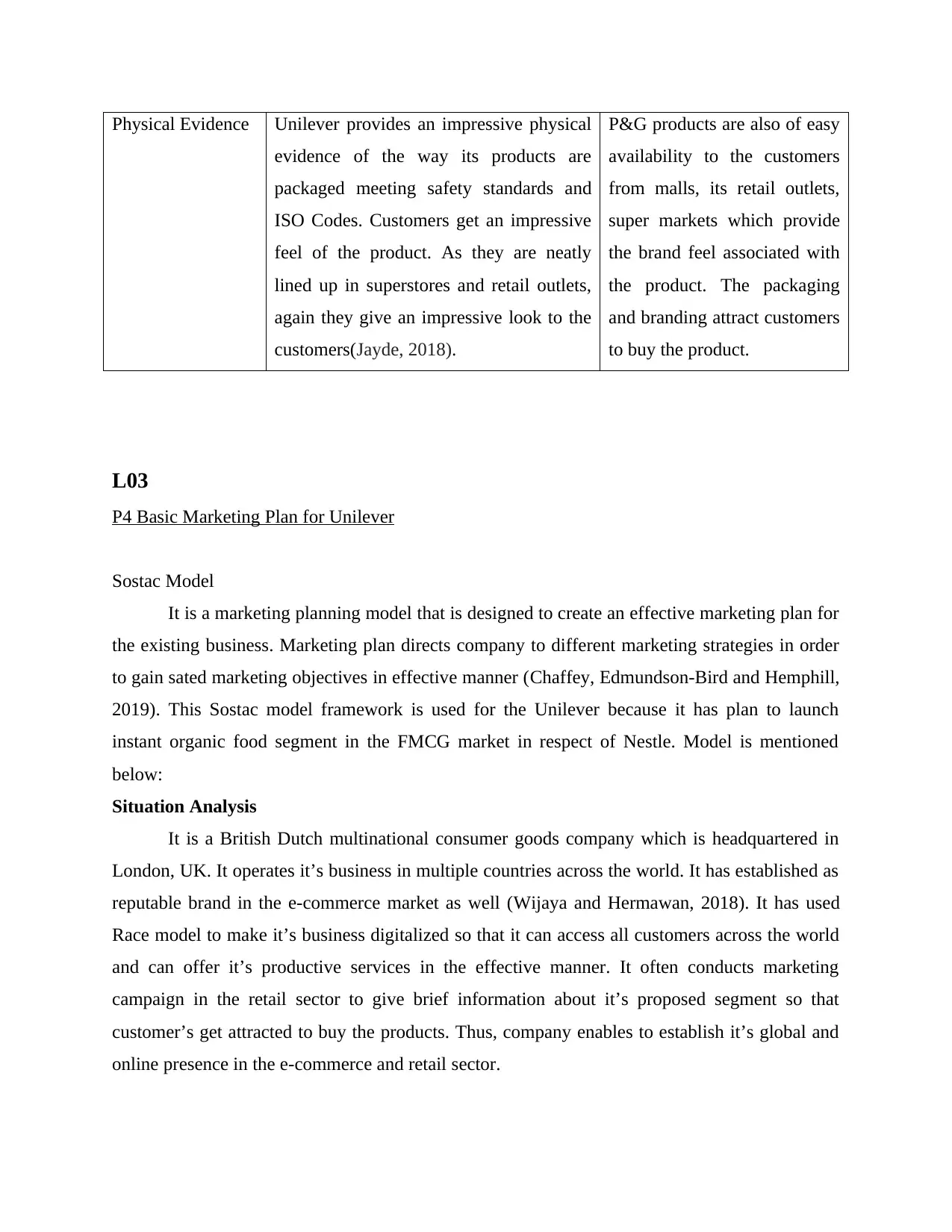
Physical Evidence Unilever provides an impressive physical
evidence of the way its products are
packaged meeting safety standards and
ISO Codes. Customers get an impressive
feel of the product. As they are neatly
lined up in superstores and retail outlets,
again they give an impressive look to the
customers(Jayde, 2018).
P&G products are also of easy
availability to the customers
from malls, its retail outlets,
super markets which provide
the brand feel associated with
the product. The packaging
and branding attract customers
to buy the product.
L03
P4 Basic Marketing Plan for Unilever
Sostac Model
It is a marketing planning model that is designed to create an effective marketing plan for
the existing business. Marketing plan directs company to different marketing strategies in order
to gain sated marketing objectives in effective manner (Chaffey, Edmundson-Bird and Hemphill,
2019). This Sostac model framework is used for the Unilever because it has plan to launch
instant organic food segment in the FMCG market in respect of Nestle. Model is mentioned
below:
Situation Analysis
It is a British Dutch multinational consumer goods company which is headquartered in
London, UK. It operates it’s business in multiple countries across the world. It has established as
reputable brand in the e-commerce market as well (Wijaya and Hermawan, 2018). It has used
Race model to make it’s business digitalized so that it can access all customers across the world
and can offer it’s productive services in the effective manner. It often conducts marketing
campaign in the retail sector to give brief information about it’s proposed segment so that
customer’s get attracted to buy the products. Thus, company enables to establish it’s global and
online presence in the e-commerce and retail sector.
evidence of the way its products are
packaged meeting safety standards and
ISO Codes. Customers get an impressive
feel of the product. As they are neatly
lined up in superstores and retail outlets,
again they give an impressive look to the
customers(Jayde, 2018).
P&G products are also of easy
availability to the customers
from malls, its retail outlets,
super markets which provide
the brand feel associated with
the product. The packaging
and branding attract customers
to buy the product.
L03
P4 Basic Marketing Plan for Unilever
Sostac Model
It is a marketing planning model that is designed to create an effective marketing plan for
the existing business. Marketing plan directs company to different marketing strategies in order
to gain sated marketing objectives in effective manner (Chaffey, Edmundson-Bird and Hemphill,
2019). This Sostac model framework is used for the Unilever because it has plan to launch
instant organic food segment in the FMCG market in respect of Nestle. Model is mentioned
below:
Situation Analysis
It is a British Dutch multinational consumer goods company which is headquartered in
London, UK. It operates it’s business in multiple countries across the world. It has established as
reputable brand in the e-commerce market as well (Wijaya and Hermawan, 2018). It has used
Race model to make it’s business digitalized so that it can access all customers across the world
and can offer it’s productive services in the effective manner. It often conducts marketing
campaign in the retail sector to give brief information about it’s proposed segment so that
customer’s get attracted to buy the products. Thus, company enables to establish it’s global and
online presence in the e-commerce and retail sector.
⊘ This is a preview!⊘
Do you want full access?
Subscribe today to unlock all pages.

Trusted by 1+ million students worldwide
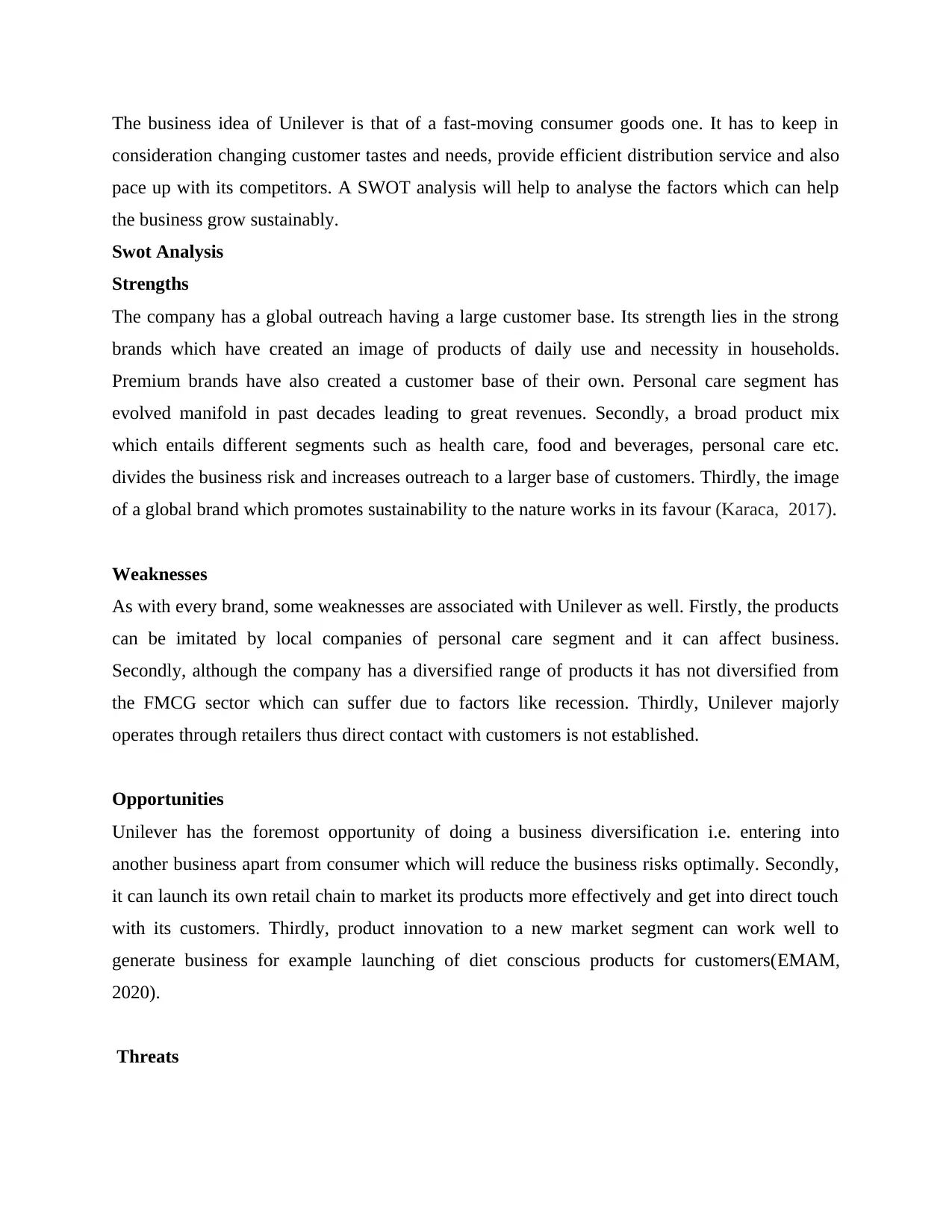
The business idea of Unilever is that of a fast-moving consumer goods one. It has to keep in
consideration changing customer tastes and needs, provide efficient distribution service and also
pace up with its competitors. A SWOT analysis will help to analyse the factors which can help
the business grow sustainably.
Swot Analysis
Strengths
The company has a global outreach having a large customer base. Its strength lies in the strong
brands which have created an image of products of daily use and necessity in households.
Premium brands have also created a customer base of their own. Personal care segment has
evolved manifold in past decades leading to great revenues. Secondly, a broad product mix
which entails different segments such as health care, food and beverages, personal care etc.
divides the business risk and increases outreach to a larger base of customers. Thirdly, the image
of a global brand which promotes sustainability to the nature works in its favour (Karaca, 2017).
Weaknesses
As with every brand, some weaknesses are associated with Unilever as well. Firstly, the products
can be imitated by local companies of personal care segment and it can affect business.
Secondly, although the company has a diversified range of products it has not diversified from
the FMCG sector which can suffer due to factors like recession. Thirdly, Unilever majorly
operates through retailers thus direct contact with customers is not established.
Opportunities
Unilever has the foremost opportunity of doing a business diversification i.e. entering into
another business apart from consumer which will reduce the business risks optimally. Secondly,
it can launch its own retail chain to market its products more effectively and get into direct touch
with its customers. Thirdly, product innovation to a new market segment can work well to
generate business for example launching of diet conscious products for customers(EMAM,
2020).
Threats
consideration changing customer tastes and needs, provide efficient distribution service and also
pace up with its competitors. A SWOT analysis will help to analyse the factors which can help
the business grow sustainably.
Swot Analysis
Strengths
The company has a global outreach having a large customer base. Its strength lies in the strong
brands which have created an image of products of daily use and necessity in households.
Premium brands have also created a customer base of their own. Personal care segment has
evolved manifold in past decades leading to great revenues. Secondly, a broad product mix
which entails different segments such as health care, food and beverages, personal care etc.
divides the business risk and increases outreach to a larger base of customers. Thirdly, the image
of a global brand which promotes sustainability to the nature works in its favour (Karaca, 2017).
Weaknesses
As with every brand, some weaknesses are associated with Unilever as well. Firstly, the products
can be imitated by local companies of personal care segment and it can affect business.
Secondly, although the company has a diversified range of products it has not diversified from
the FMCG sector which can suffer due to factors like recession. Thirdly, Unilever majorly
operates through retailers thus direct contact with customers is not established.
Opportunities
Unilever has the foremost opportunity of doing a business diversification i.e. entering into
another business apart from consumer which will reduce the business risks optimally. Secondly,
it can launch its own retail chain to market its products more effectively and get into direct touch
with its customers. Thirdly, product innovation to a new market segment can work well to
generate business for example launching of diet conscious products for customers(EMAM,
2020).
Threats
Paraphrase This Document
Need a fresh take? Get an instant paraphrase of this document with our AI Paraphraser
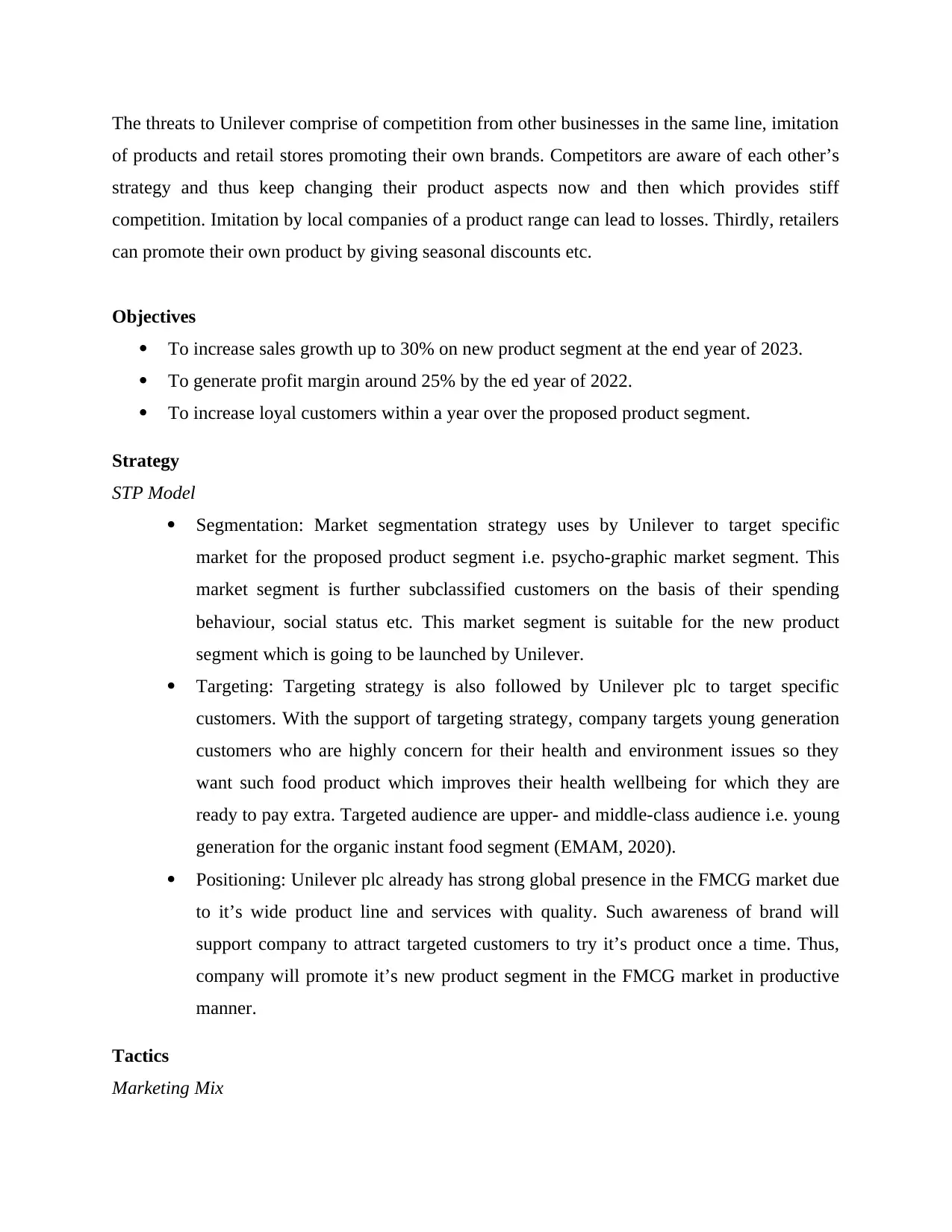
The threats to Unilever comprise of competition from other businesses in the same line, imitation
of products and retail stores promoting their own brands. Competitors are aware of each other’s
strategy and thus keep changing their product aspects now and then which provides stiff
competition. Imitation by local companies of a product range can lead to losses. Thirdly, retailers
can promote their own product by giving seasonal discounts etc.
Objectives
To increase sales growth up to 30% on new product segment at the end year of 2023.
To generate profit margin around 25% by the ed year of 2022.
To increase loyal customers within a year over the proposed product segment.
Strategy
STP Model
Segmentation: Market segmentation strategy uses by Unilever to target specific
market for the proposed product segment i.e. psycho-graphic market segment. This
market segment is further subclassified customers on the basis of their spending
behaviour, social status etc. This market segment is suitable for the new product
segment which is going to be launched by Unilever.
Targeting: Targeting strategy is also followed by Unilever plc to target specific
customers. With the support of targeting strategy, company targets young generation
customers who are highly concern for their health and environment issues so they
want such food product which improves their health wellbeing for which they are
ready to pay extra. Targeted audience are upper- and middle-class audience i.e. young
generation for the organic instant food segment (EMAM, 2020).
Positioning: Unilever plc already has strong global presence in the FMCG market due
to it’s wide product line and services with quality. Such awareness of brand will
support company to attract targeted customers to try it’s product once a time. Thus,
company will promote it’s new product segment in the FMCG market in productive
manner.
Tactics
Marketing Mix
of products and retail stores promoting their own brands. Competitors are aware of each other’s
strategy and thus keep changing their product aspects now and then which provides stiff
competition. Imitation by local companies of a product range can lead to losses. Thirdly, retailers
can promote their own product by giving seasonal discounts etc.
Objectives
To increase sales growth up to 30% on new product segment at the end year of 2023.
To generate profit margin around 25% by the ed year of 2022.
To increase loyal customers within a year over the proposed product segment.
Strategy
STP Model
Segmentation: Market segmentation strategy uses by Unilever to target specific
market for the proposed product segment i.e. psycho-graphic market segment. This
market segment is further subclassified customers on the basis of their spending
behaviour, social status etc. This market segment is suitable for the new product
segment which is going to be launched by Unilever.
Targeting: Targeting strategy is also followed by Unilever plc to target specific
customers. With the support of targeting strategy, company targets young generation
customers who are highly concern for their health and environment issues so they
want such food product which improves their health wellbeing for which they are
ready to pay extra. Targeted audience are upper- and middle-class audience i.e. young
generation for the organic instant food segment (EMAM, 2020).
Positioning: Unilever plc already has strong global presence in the FMCG market due
to it’s wide product line and services with quality. Such awareness of brand will
support company to attract targeted customers to try it’s product once a time. Thus,
company will promote it’s new product segment in the FMCG market in productive
manner.
Tactics
Marketing Mix
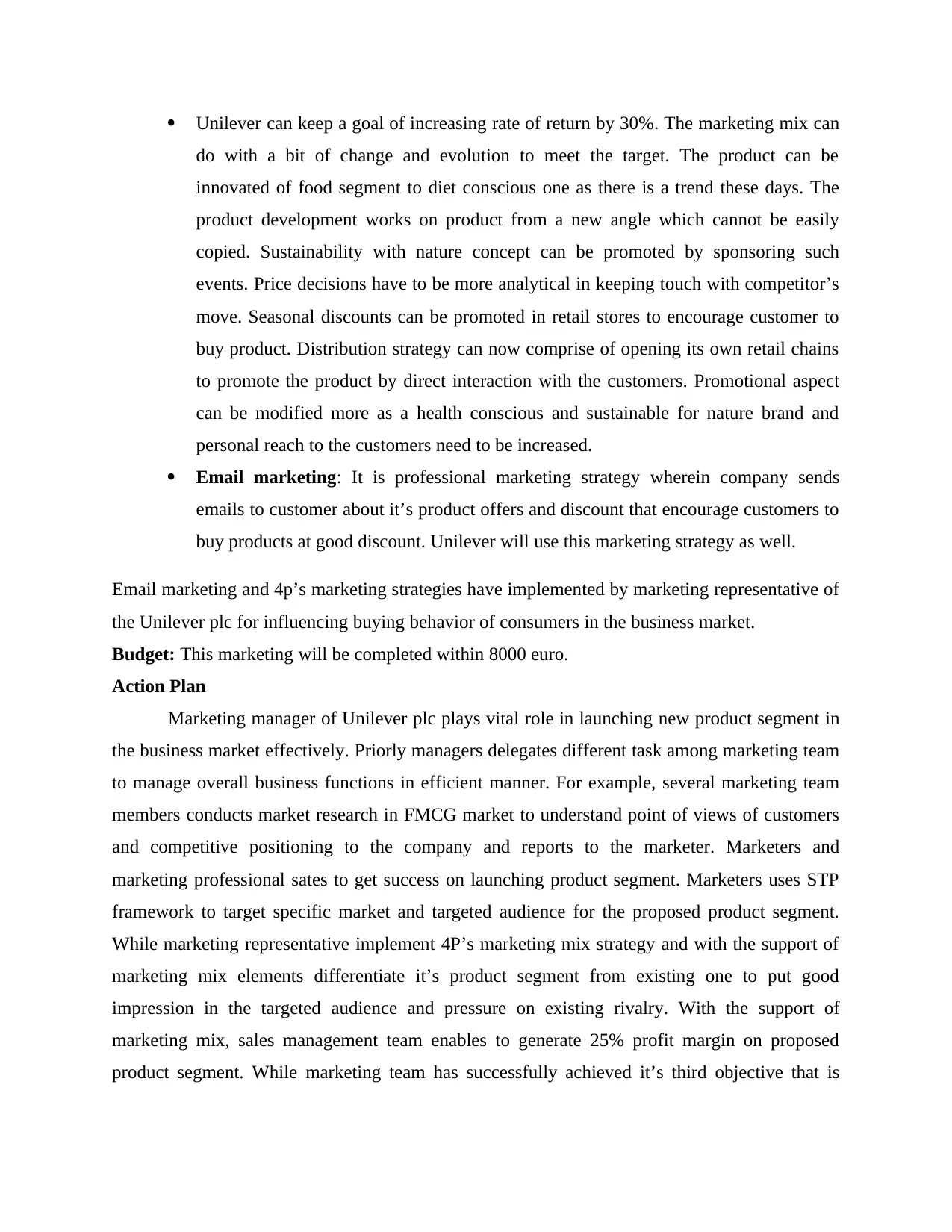
Unilever can keep a goal of increasing rate of return by 30%. The marketing mix can
do with a bit of change and evolution to meet the target. The product can be
innovated of food segment to diet conscious one as there is a trend these days. The
product development works on product from a new angle which cannot be easily
copied. Sustainability with nature concept can be promoted by sponsoring such
events. Price decisions have to be more analytical in keeping touch with competitor’s
move. Seasonal discounts can be promoted in retail stores to encourage customer to
buy product. Distribution strategy can now comprise of opening its own retail chains
to promote the product by direct interaction with the customers. Promotional aspect
can be modified more as a health conscious and sustainable for nature brand and
personal reach to the customers need to be increased.
Email marketing: It is professional marketing strategy wherein company sends
emails to customer about it’s product offers and discount that encourage customers to
buy products at good discount. Unilever will use this marketing strategy as well.
Email marketing and 4p’s marketing strategies have implemented by marketing representative of
the Unilever plc for influencing buying behavior of consumers in the business market.
Budget: This marketing will be completed within 8000 euro.
Action Plan
Marketing manager of Unilever plc plays vital role in launching new product segment in
the business market effectively. Priorly managers delegates different task among marketing team
to manage overall business functions in efficient manner. For example, several marketing team
members conducts market research in FMCG market to understand point of views of customers
and competitive positioning to the company and reports to the marketer. Marketers and
marketing professional sates to get success on launching product segment. Marketers uses STP
framework to target specific market and targeted audience for the proposed product segment.
While marketing representative implement 4P’s marketing mix strategy and with the support of
marketing mix elements differentiate it’s product segment from existing one to put good
impression in the targeted audience and pressure on existing rivalry. With the support of
marketing mix, sales management team enables to generate 25% profit margin on proposed
product segment. While marketing team has successfully achieved it’s third objective that is
do with a bit of change and evolution to meet the target. The product can be
innovated of food segment to diet conscious one as there is a trend these days. The
product development works on product from a new angle which cannot be easily
copied. Sustainability with nature concept can be promoted by sponsoring such
events. Price decisions have to be more analytical in keeping touch with competitor’s
move. Seasonal discounts can be promoted in retail stores to encourage customer to
buy product. Distribution strategy can now comprise of opening its own retail chains
to promote the product by direct interaction with the customers. Promotional aspect
can be modified more as a health conscious and sustainable for nature brand and
personal reach to the customers need to be increased.
Email marketing: It is professional marketing strategy wherein company sends
emails to customer about it’s product offers and discount that encourage customers to
buy products at good discount. Unilever will use this marketing strategy as well.
Email marketing and 4p’s marketing strategies have implemented by marketing representative of
the Unilever plc for influencing buying behavior of consumers in the business market.
Budget: This marketing will be completed within 8000 euro.
Action Plan
Marketing manager of Unilever plc plays vital role in launching new product segment in
the business market effectively. Priorly managers delegates different task among marketing team
to manage overall business functions in efficient manner. For example, several marketing team
members conducts market research in FMCG market to understand point of views of customers
and competitive positioning to the company and reports to the marketer. Marketers and
marketing professional sates to get success on launching product segment. Marketers uses STP
framework to target specific market and targeted audience for the proposed product segment.
While marketing representative implement 4P’s marketing mix strategy and with the support of
marketing mix elements differentiate it’s product segment from existing one to put good
impression in the targeted audience and pressure on existing rivalry. With the support of
marketing mix, sales management team enables to generate 25% profit margin on proposed
product segment. While marketing team has successfully achieved it’s third objective that is
⊘ This is a preview!⊘
Do you want full access?
Subscribe today to unlock all pages.

Trusted by 1+ million students worldwide
1 out of 15
Related Documents
Your All-in-One AI-Powered Toolkit for Academic Success.
+13062052269
info@desklib.com
Available 24*7 on WhatsApp / Email
![[object Object]](/_next/static/media/star-bottom.7253800d.svg)
Unlock your academic potential
Copyright © 2020–2025 A2Z Services. All Rights Reserved. Developed and managed by ZUCOL.




